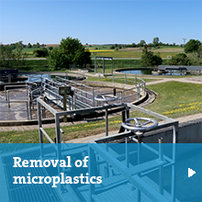Microplastics in the environment
Plastic has become an integral part of our everyday life. However, plastic waste, including microplastics, leads to ecological and health problems. Still little is known about the magnitude of the problem. Eawag is therefore investigating the effects of microplastics in water and bodies of water and is developing solutions to reduce microplastic contamination.
There is a lot of plastic waste in the environment and in our waters: beverage bottles, plastic bags, packaging, straws and much more. Less well visible to the naked eye, but nevertheless no less common, are what are known as microplastics. This page provides information about what exactly microplastics are and what quantities occur in Swiss waters.
News
May 21, 2025
Experts
Further informationen
- Plastik zirkuliert überall, article in Wohnen Extra Dezember 2022
- Plastics in the environment - Report of the Federal Council in fulfillment of three postulates (September 2022; in German and French)
- Mikroplastik in der Umwelt, article in Aqua & Gas, 10-2021
- Award-winning researcher is tracing microplastics in our drinking water, video with Prof. Denise Mitrano, ETH Zurich
- Mikroplastik in der Umwelt, fact sheet Ecotox Centre, July 2015
- Plastics, web site FOEN with numerous tips on recycling and proper disposal of plastic waste
- Évaluation de la pollution par les plastiques dans les eaux de surface en Suisse, report EPFL and FOEN, 2014
- Mikroplastik in Abwasser und Gewässer, report AWEL, Canton Zürich, 2019
- Rapporto microplastiche, information of the Cantonal Environmental Office of Ticino
- microplastics.ch – a research network, Swiss research groups working on microplastics
- LIFE Blue Lakes project tackles the problem of microplastics in lakes through a set of governance, training, information and awareness actions, addressed to institutions, relevant stakeholders and citizens. It is co-financed by the European Commission through the LIFE Programme and PlasticsEurope.
















